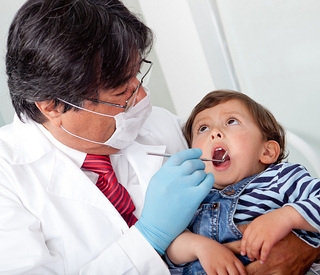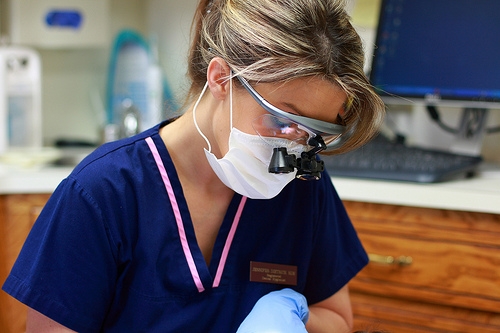July 15th, 2015

First aid training is a must when you are a parent. You can put on a bandage with your eyes closed. Perhaps even apply butterfly tape to avoid stitches. What about a dental injury? Do you have a checklist in mind on what to do when a tooth is knocked out, broken, or displaced from impact? All of these situations happen often and should be in a parent’s emergency training regiment. Luckily Drs. Sidney and Jacob Kelly and our team are here to be a resource for such an incident!
Children’s most common dental injury is chipping a front tooth. It is so common that it seems like a right of passage. Say, for example, a two year old trips and hits her front teeth on the tile floor. First, check to see if the teeth have been broken to the nerve. You can tell if you see layers and a pinkish center. Then, wiggle each tooth and make sure it is not loose. If the teeth feel firmly in place, that is a good sign. Even if they are a little loose, the teeth will tighten again with time. If she develops a severe temperature or bite sensitivity then you know treatment is needed, which may include a root canal. If there are minor symptoms that diminish with time, continued observation will be fine.
Knocking out a tooth is also common and requires more attention than observation alone. As soon as possible, locate the tooth, touch only the crown (not the root), and rinse any debris gently with milk or water. Place it back into the tooth socket as soon as possible. The American Association of Endodontists states a tooth has a high chance of survival and retention for life if it is re-implanted within five minutes or up to 60 minutes if soaking in milk or saline solution. Our team at Sidney D. Kelly, DMD Family and Cosmetic Dentistry know many parents are nervous about the thought of doing this alone, but not to worry, our team is here to help!
Here’s another dental emergency example: Your child takes an elbow to the mouth during a basketball game and severely displaces a tooth but does not knock it out. What to do? First, apply light pressure in an attempt to move it back into place. Be extremely careful not to use excessive force. Place a cold pack for swelling and contact our office as soon as possible.
A dental emergency can be frightening. It is often messy and painful. The best initial reaction is to remain calm, and remember that we are here to help! Contact us at our Roseville, CA office if your child encounters a dental emergency.
July 8th, 2015

When children lose baby teeth, it’s a time to rejoice. But when adults suffer from tooth loss, it may be a sign of a serious problem. That’s when it’s time to give us a call at Sidney D. Kelly, DMD Family and Cosmetic Dentistry.
What are the reasons for missing teeth?
The loss of permanent teeth can occur for a variety of reasons, ranging anywhere from hereditary factors to tooth decay to traumatic injury. Here are the following reasons why adults suffer tooth loss:
- Gum disease: The number one cause of lost teeth in adults is gum disease, also known as periodontal disease, an infection of the structures that support the teeth. Once gum disease reaches and destroys the alveolar bone, the teeth begin to loosen and will eventually fall out or need to be extracted.
- Tooth decay: If cavities are left untreated, they can destroy tooth structure as well as cause infection in the supporting bone.
- Tooth injury: An injury can either knock out a tooth immediately or cause damage to the root or pulp that will later require extraction. We recommend using a mouthguard if you play sports.
- Tooth fracture: A fracture in a tooth is often caused by teeth grinding, or what Drs. Sidney and Jacob Kelly and our team call bruxism. A crown may be the answer, but depending on the location of the crack or fracture and how deeply it extends, the tooth may not respond well to repair with a crown and may need to be extracted instead.
What are the risk factors for tooth loss?
- Poor oral hygiene: Patients who only occasionally brush or floss their teeth are more likely to develop tartar, plaque buildup, and other bacteria that cause decay.
- Not visiting the dentist: Seeing Drs. Sidney and Jacob Kelly every six months for a cleaning and checkup prevents any developing oral health issues, as well as ensures that plaque and tartar do not build up over time.
- Smoking: Smokers and users of smokeless tobacco are more likely to develop periodontal disease that can cause tooth loss. If you are a smoker it is crucial to visit us on a timely schedule.
- Various health conditions: Patients with high blood pressure, diabetes, rheumatoid arthritis, and other chronic health issues are more likely to suffer from gum disease.
Scheduling an appointment with Drs. Sidney and Jacob Kelly at our Roseville, CA office will give you an accurate diagnosis and a variety of treatment options. It’s important to know that periodontal disease is “silent,” meaning you will not always experience pain as a signal of infection. When caught early, treatments are usually successful.
Give us a call today to schedule your next visit!
July 1st, 2015

Happy Independence Day from Drs. Sidney and Jacob Kelly and team! The Fourth of July celebrations in America may have changed a lot over the years, but there is no doubt that we Americans love to celebrate the anniversary of our country's independence! Today we're devoting the Sidney D. Kelly, DMD Family and Cosmetic Dentistry blog to some fun facts about the Fourth!
- My, how we have grown! This year the United States Census Bureau estimates that our country has 313.9 million residents celebrating the Fourth of July this year, but back in 1776 there were just 2.5 million members of the country.
- Our country loves to show how proud that we are of our independence. Did you know that there are 31 United States places with the word “Liberty” in their names? The state of Iowa actually has four towns with the word Liberty in the name: Libertyville, New Liberty, North Liberty, and West Liberty.
- The United States loves Fourth of July food! It is expected that around 150 million hot dogs are eaten on the Fourth each year. One of the Fourth's most popular sides, potato salad, goes just perfectly with the hotdogs and hamburgers that are standard Fourth of July fare. Some people choose potato chips instead, but we wouldn't have such a plethora of potatoes if not for the prodigious production of the states of Idaho and Washington -- they provide about half of all the potatoes in the United States today!
- Americans love celebrating the Fourth outdoors: About 74 million Americans fire up their BBQ grill every Fourth of July.
- The Chinese contribution: Did you know that Americans have spent more than $211 million on fireworks that were imported from China?
No matter how your family chooses to celebrate the Fourth, stay safe, take precautions, and don't forget to brush after your fabulous Fourth feast!
June 24th, 2015

An article was released to the public stating that dental X-rays contribute to a type of brain cancer. After reading an article like this, your first thought may be to avoid dental X-rays, but you may want to hold off on that quick judgment. As with any treatment we offer at Sidney D. Kelly, DMD Family and Cosmetic Dentistry, education is your most valuable tool in deciding what is best for you.
How often dental X-rays are taken is based on risk for infection, physical symptoms, and clinical findings. The American Dental Association (ADA) is a governing body over the dental profession. The ADA states, “ . . . healthy adults receive routine mouth X-rays every two to three years. Dental X-rays are recommended every one to two years for children and every 1.5 to three years for teens. Children often require more X-rays than adults because of their developing teeth and jaws and increased likelihood for cavities.”
A "caries risk category" often determines how often dental X-rays are taken. The most recent documented resource to determine a caries risk is Caries Management by Risk Assessment (CAMBRA). This was adopted by the ADA and is used by dental professionals giving interval recommendations for X-rays.
With knowledge of your risk for dental infection, you will be informed by Drs. Sidney and Jacob Kelly of the interval at which dental X-rays should be taken. You can rest assured that the standards published by the ADA have been researched extensively and are there to protect your personal health and safety.
Dental X-rays are most commonly digital, which significantly reduces exposure. There is more radiation exposure from the sun or in an airplane than in a dental X-ray. It is common practice to use a lead apron with a thyroid collar for protection during X-ray exposure.
Having a cavity means having an active, potentially harmful infection. Diagnosing such infection with minimal exposure through digital dental X-rays at our Roseville, CA office does more good than harm.




